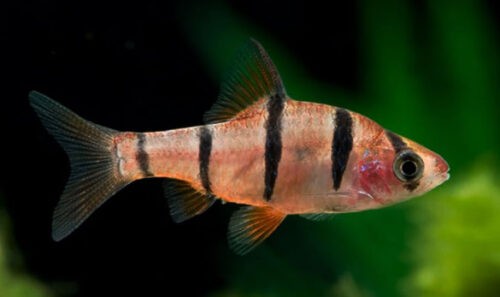The five-banded barb is an excellent and popular aquarium fish which is also known as pentazona barb,Banded Barb, Five band Barb etc. It belongs to the family Cyprinidae under order Cypriniformes of class Actinopyterygii. It is native to South East Asia. It prefers to live in slow flowing water bodies such as ditches, small rivers, floodplains.
Systematic Position
- Phylum:Chordata
- Subphylum: Vertebrata
- Class: Actinopterygii
- Order: Cypriniformes
- Family: Cyprinidae
- Genus: Desmopuntius
- Species: Desmopuntius pentazona
Physical Description
It is a small aquarium fish with a body length of up to 5 cm. The body is elongated and more or less laterally compressed. There are two pairs of barbells around the mouth. The body is painted with yellowish silver color.

Five-banded Barb: Desmopuntius pentazona
There are five blue-black transverse bands on each side: one band runs through the eye, the second near the gill cover, the third from the front edge of the dorsal fin to the pelvic fins, the fourth is situated behind the rear edge of the dorsal fin to the front edge of the anal fin while the fifth is located almost on the border of the caudal fin. The back is reddish-brown in color. The dorsal, anal and caudal fins are transparent, and red in color.
Important Info
- Scientific name:Desmopuntius pentazona
- Origin: Southeast Asia
- Grown up size: 5 cm
- Breeding: Egg layer
- Diet: Omnivore
- Temperament: Peaceful
- Water pH: 6.5-7.5
- Water hardness: 5.0-8.0 dGH
- Water temperature: 26-28 ° C (78.4-82.40 F)
- Tank size: 15 gallons or larger
- Tank level: Middle
- Care level: Easy
- Life span:5-8 years
Feeding
They are omnivorous fish and mainly feed on worms, crustaceans, small insects, bloodworms, Tubifex, Corethra and other various zooplankton. In aquarium condition, you may offer them live and frozen foods such as Artemia, Daphnia, mosquito larvae, etc. Besides, you may also feed them with flake and micropellets. You should also give them food vegetable food such as lettuce, spinach. Feed should be offered 2-3 times daily.
Housing
It is a community fish. It prefers to make flocks of eight to ten individuals. They need 15 gallons of tank volume. They prefer the old and soft (with a hardness of less than 15 degrees), a slightly acidic or neutral water (pH 6.5-7.0). The water temperature in the tank should be 26-28 ° C.
The aquarium must be densely planted with aquatic plants such as Cryptocoryne, Echinodorus, Vallisneria, Elodea and others. On the surface, it is desirable to place floating plants such as Salvini, water lettuce and other. The soil in the aquarium is desirable dark of gravel or pebbles. Once a week, one-fifth of the water is replaced with a freshwater.
It is a peaceful fish and it can be kept with other types of barbs such as Sumatran, scarlet, cherry barbs as well as with other peaceful fish.
Sexing
At the young stages, it is difficult to make differences between the male and female. Generally mature males are slightly smaller and slimmer with more brilliant colorful than females. During the spawning season, the mature female bears fuller body when she carries eggs in her belly.
Breeding
It is an egg layers and it can easily breed in aquarium condition. The breeding tank should have small leaved shrub plants and good water parameters with a pH of 6.5-7.0, hardness of 4.0-10 dGH, water temperature of 25-28 ° C.
The tank should also have weak aeration, and natural lighting system that should be 0.25 watt per liter of water. Before spawning the parents should be conditioned with live and vitamin enriched food for 7-10 days. Spawning generally occurs in the morning. The mature female lays up to 200 eggs on the coarse gravel bed.
The eggs hatch within 1-2 days and the fry become active within 2-5 days. The fry should be fed with infusonia, brine shrimp, and rotifers.
Final Thoughts
The five banded barb is a very attractive and popular aquarium fish due to its body coloration and hardiness. It is available in local pet shop with normal prices. It is sometimes affected with some water borne diseases. To keep your fish healthy, proper tank management must be maintained on regular basis.
You might also read: Guppy fish
